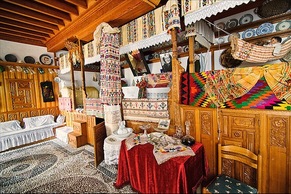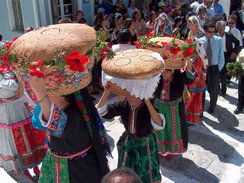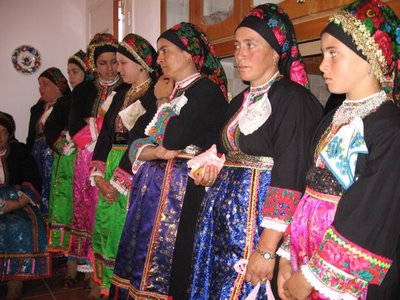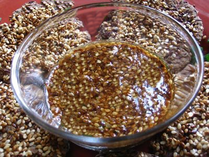A Home of Culture and Tradition

Although the southern Dodecanese island of Karpathos has been discovered worldwide over the last decade by tourists seeking less commercialism and more untainted culture, most of the island has remained unchanged by their presence, unlike the more renowned Greek islands, like Mykonos and Santorini. Karpathos’ claim to fame includes its exceptional landscapes and traditional architecture, influenced in style by the Aegean and Venetian characteristics of its neighboring islands—styles that interweave to create a one-of-a-kind splendor.
|
Olympos is the most authentic medieval village in Karpathos, well known for its period architecture, evident in its picturesque windmills, and rustic lifestyle. Geographically segregated from the rest of the island, Olympos was able to preserve its own unspoiled traditions, ironically drawing more tourists than any of the other island towns.
While simple square houses painted in bright colors traditionally make up the villages outside of Olympos, the entire island comes together when it comes to maintaining a Karpathian House. This is a beloved constant that exists throughout Karpathos, regardless of location. |
Inside the Karpathiko Spiti (Καρπάϑικο Σπίτι)
 Two steps leading up to the soufas (center), panosoufi (upper left), cabinets (next to steps)
Two steps leading up to the soufas (center), panosoufi (upper left), cabinets (next to steps)
The center of the main house is the ground floor which is separated into two sections: the patos (the lower living area), and, opposite from the house entrance, the raised soufas (traditional bed) with the mousandra (guest room/loft) and the panosoufi (the upper bed for a guest in the mousandra). This could be where the "loft" originated!
 Panga (left in white), side view of panosoufi, pebble floor
Panga (left in white), side view of panosoufi, pebble floor
Many of the houses have floors composed of white, pink, and black pebbles arranged in a decorative pattern, and wooden rafters on the ceiling.

The woodwork is prominently on display in the soufas, which is a couple of steps up from the main floor and preceded by a beautifully crafted wood frame. Climb another two steps and you have the mousandra and the panosoufi. On the east side of the house is the skillfully carved wooden family altar, the home’s all-important spiritual hub.
 Irene's House, Olympos, Karpathos: soufas (left to center) and panosoufi (right)
Irene's House, Olympos, Karpathos: soufas (left to center) and panosoufi (right)
The kellos (kitchen) in the Karpathian House—complete with a fireplace and anakapnea (chimney)—is where the stovetop cooking happens (think avgolemono soup, skordalia, stifado, and dolmades). This is the core of daily family life, as it is in most modern homes…hey, we all love to eat and there’s no better place to be to steal a taste before dinner.
The outdoor oven keeps the heat out of the main house in the hot summer months, and it’s also used by neighboring families. This is where the bread, kouloures, and spanakopites are made. Can you smell them? Yum!
Krevati
|
This is the term used on the islands to describe the preparation of a wedding, in particular the couple’s new home, with each island imparting slight nuances in the details of this custom.
Typically the night before a couple gets married in Karpathos, the family is invited to the newlyweds’ house for a "krevati" where they decorate the dwelling and their new bed to make it festive for the couple’s arrival. The elaborate preparation comes in the form of a procession as goods are carried through the village and up to the house. It is adorned with beautiful bedspreads and fabrics that were embroidered, crocheted, and knitted after the engagement was announced. A large wooden pillar in the center of the house supports the roof beam, symbolizing the support of the family. This pillar is decked out with silk fabrics embellished with colorful needlework for the wedding (as is the bride) and other special celebrations—this is every Karpathian’s opportunity to take home-décor to the extreme, representing their richness in hospitality. Sumptuous island dishes, exotic beverages, and delectable pastries fill the dinner menus that extend that richness to guests as they gather for the joyous occasion. |

Many of the island’s hotels are decorated in the Karpathos-House style to give their guests a feel for the tradition that is held in such high regard here.
The remarkable dedication of the Karpathian people to their traditions, folklore, and customs is just one of the many elements that makes this island a true gem in the Aegean.
I hope you enjoyed your visit to the Karpathian House. Stay tuned for more culture, food, and fun from this, our favorite island in upcoming blogs. To learn more about our wedding customs, check out our blog The Wedding Season~Karpathos Style.
Sign up for our e-newsletter (if you haven’t already) and stay connected on social media for cooking tips and recipes, as well as for all Kukla's Kouzina updates and news.
Thanks for following us and we’ll see you next Monday!
Until then~
Kali orexi! Good appetite!
Kelly
Web design by Kelly Salonica Staikopoulos














































